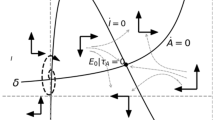Abstract
We present a model of capital accumulation and technology adoption in a vintage-capital framework. The model is an infinite-horizon/infinite-dimensional optimal control model: the firm employs a continuum of technologies (a continuum of heterogeneous capital goods). Capital goods are technology specific, their technology is related to vintage and technology progress. The entrepreneur maximizes the profits obtained by employing a continuum of technologies under the assumption of constant returns to scale and bearing adjustment costs for gross investments. The diffusion of a new technology is established by allowing the entrepreneur to invest in vintage capital goods.
Similar content being viewed by others
References
Abel, A. (1990): “Consumption and Investment.” InHandbook of Monetary Economics, edited by B. Friedman and F. Hahn, vol. II, pp. 725–777. Amsterdam: North-Holland.
Arrow, K. (1962): “The Economic Implications of Learning by Doing.”Review of Economic Studies 29: 155–173.
Barucci, E., and Gozzi, F. (1996): “Investments in a Vintage-capital Model.”Research in Economics 52: 159–188.
Barucci, E., and Gozzi, F. (1999): Technology Adoption and Accumulation in a Vintage-capital Model. Dipartimento di Statistica e Matematica Applicata all' Economia, preprint.
Benhabib, J., and Rustichini, A. (1991): “Vintage-capital, Investment, and Growth.”Journal of Economic Theory 55: 323–339.
Bensoussan, A., Da Prato, G., Delfour, M. and Mitter, S. (1992):Representation and Control of Infinite Dimensional Systems. Boston: Birkhäuser.
Boucekkine, R., Germain, M., and Licandro, O. (1997): “Replacement Echoes in the Vintage-capital Growth Model.”Journal of Economic Theory 74: 333–348.
Boucekkine, R., del Rio F., and Licandro, O. (1999): “Endogenous vs. Exogenous Driven Fluctuations in Vintage-capital Models.”Journal of Economic Theory 88: 161–187.
Brezis, H. (1983):Lécons d'analyse fonctionnelle. Paris: Masson.
Cannarsa, P., and Tessitore, M. (1994): Optimality Conditions for Boundary Control Problems of Parabolic Type. InProceedings International Conference on Distributed Control System: Nonlinear Problems. Basel: Birkhäuser.
Carlson, D., Haurie, B., and Leizarowitz, A. (1991):Infinite Horizon Optimal Control. New York: Springer.
Chari, V., and Hopenhayn (1991): “Vintage Human Capital, Growth and The Diffusion of New Technology.”Journal of Political Economy 99: 1142–1165.
Fattorini, H. (1968): “Boundary Control System.”Siam Journal of Control and Optimization 6: 349–385.
Gilchrist, S., and Williams, J. (1998): Putty Clay and Investment: A Business Cycle Analysis. Federeal Reserve Board, Working paper 1998-30.
Gould, J. (1968): “Adjustment Costs in the Theory of Investment of the Firm.”Review of Economic Studies 35: 47–55.
Gozzi, F., and Tessitore, M. (1994): “Optimality Conditions for Dirichlet Boundary Control Problems of Parabolic Type.”Journal of Mathematical Systems, Estimation and Control 8 (1) 1998; complete electronic version: January 1998, code 08113.
Grossman, G., and Helpman, E. (1991a): “Quality Ladders and Product Cycles.”Quarterly Journal of Economics 51: 557–586.
Grossman, G., and Helpman, E. (1991b): “Quality Ladders in the Theory of Growth.”Review of Economic Studies 58: 43–61.
Iannelli, M. (1995):Mathematical Theory of Age Structured Population Dynamics. Applied Mathematics Monographs, CNR. Pisa: Giardini Editore.
Johansen, L. (1959): “Substitution versus Fixed Proportion Coefficients in the Theory of Capital Growth.”Econometrica 27: 1157–1176.
Jovanovic, B., and Lach, S. (1989): “Entry, Exit, and Diffusion with Learning by Doing.”American Economic Review 79: 690–699.
Jovanovic, B., and MacDonald, G. (1994): Competitive Diffusion.Journal of Political Economy 102: 24–52.
Jovanovic, B., and Rob, R. (1989): “The Growth and Diffusion of Knowledge.”Review of Economic Studies 56: 569–582.
Judd, K. (1985): “On the Performance of Patents.”Econometrica 53: 567–585.
Lasiecka, I., and Triggiani, R. (1991): “Differential and Algebraic Equations with Application to Boundary Control Problems: Continuous Theory and Approximation Theory.” InLecture Notes in Control and Information Sciences, p. 164. Berlin Heidelberg: Springer.
Li, X. and Yong, J (1995):Infinite Dimensional Optimal Control Theory. Boston: Birkhäuser
Lions, J., and Magenes, E. (1968):Problèmes aux limites non homogènes et applications II. Paris: Dunod.
Lucas, R. (1991): “Making a Miracle.”Econometrica 61: 251–272.
Mitra, T., Ray, D., and Roy, R. (1991): “The Economics of Orchards: An Exercise in Point-Input, Flow-Ouput Capital Theory.”Journal of Economic Theory 53: 12–50.
Mitra, T., and Wan, H. (1985): “Some Theoretical Results on the Economics of Forestry.”Review of Economic Studies 52: 263–282.
Mitra, T., and Wan, H. (1986): “On the Faustmann Solution to the Forest Management Problem.”Review of Economic Studies 52: 229–249.
Musiela, M. (1993): Stochastic PDEs and Term Structure Models. Journées Internationales de Finance, IGR-AFFI, La Baule.
Nagel, R., and Sinestrari, E. (1994): “Inhomogeneous Volterra Integrodifferential Equations for Hille-Yosida Operators.” InFunctional Analysis, edited by Bierstedt, Pietsch, R. V. Lecture Notes in Pure and Applied Mathematics 150, pp. 51–70. New York: Marcel Dekker.
Parente, S. (1995): “A Model of Technology Adoption and Growth.”Economic Theory 6: 405–420.
Parente, S., and Prescott, E. (1994): “Barriers to Technology Adoption.”Journal of Political Economy 102: 298–321.
Pazy, A. (1983):Semigroups of Linear Operators and Applications to Partial Differential Equations. New York: Springer.
Romer, P. (1990): “Endogenous Technological Change.”Journal of Political Economy 98: 71–102.
Segerstrom, P. (1991): “Innovation, Imitation, and Economic Growth.”Journal of Political Economy 99: 806–827.
Seiersted, A., and Sydsaeter (1985):Optimal Control Theory with Economic Applications. Amsterdam: North Holland 1987.
Sheshinsky, E. (1967): “Balanced Growth and Stability in the Johansen Vintage-capital Model.”Review of Economic Studies 34: 239–248.
Solow, R. (1959): “Investment and Technological Progress.” InMathematical Methods in the Social Sciences, edited by Arrow, Karlin, and Suppes. Stanford University Press.
Solow, R., Tobin, J., von Weizsacker, and Yaari, M. (1966): “Neoclassical Growth with Fixed Factor Proportions.”Review of Economic Studies 33: 79–115.
Stokey, N. (1988): “Learning by Doing and the Introduction of New Goods.”Journal of Political Economy 96: 707–717.
Tessitore, E. (1995): “Optimality Condition for Infinite Horizon Optimal Control Problems.”Bollettino UMI 101(7): 795–814.
Yosida, K. (1980):Functional Analysis. New York: Springer.
Young, A. (1993a): “Invention and Bounded Learning by Doing.”Journal of Political Economy 101: 443–472.
Young, A. (1993b): “Substitution and Complementarity in Endogenous Innovation.”Quarterly Journal of Economics 108: 775–807.
Author information
Authors and Affiliations
Rights and permissions
About this article
Cite this article
Barucci, E., Gozzi, F. Technology adoption and accumulation in a vintage-capital model. Zeitschr. f. Nationalökonomie 74, 1–38 (2001). https://doi.org/10.1007/BF01231214
Received:
Revised:
Issue Date:
DOI: https://doi.org/10.1007/BF01231214




